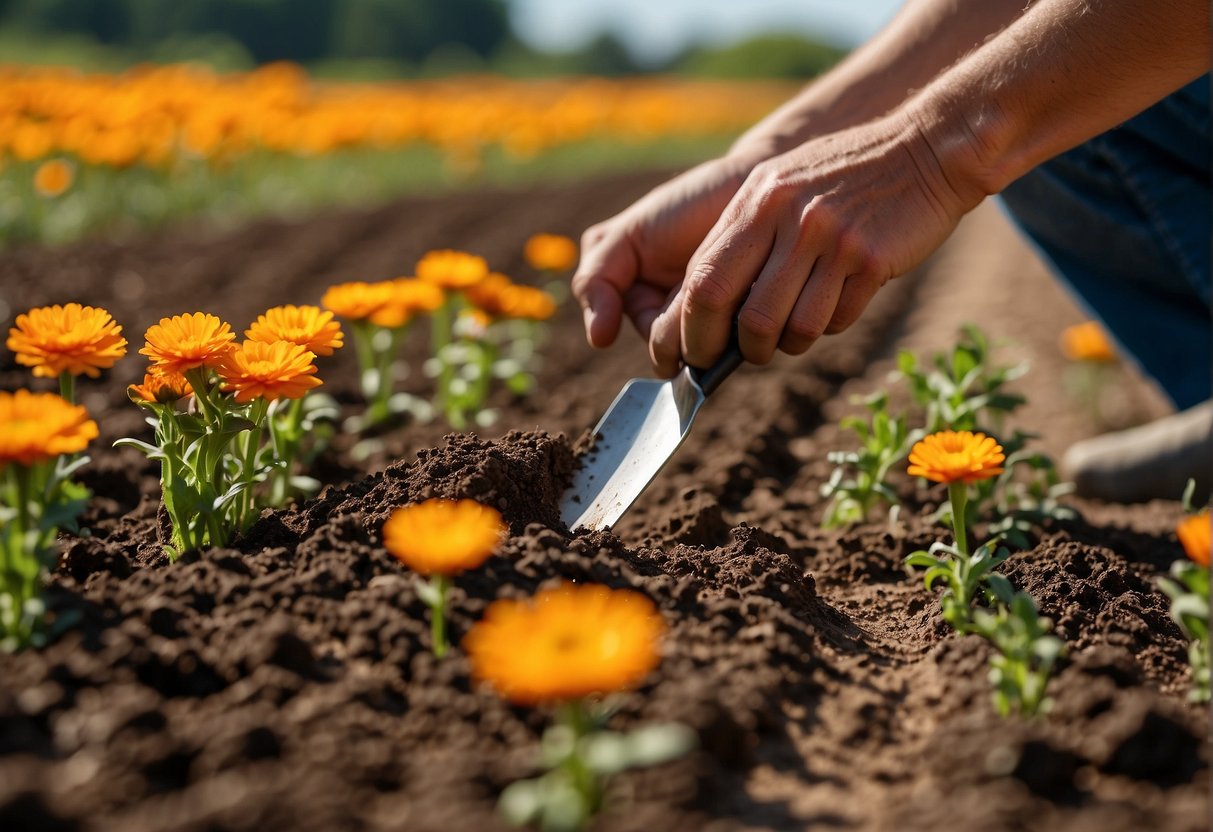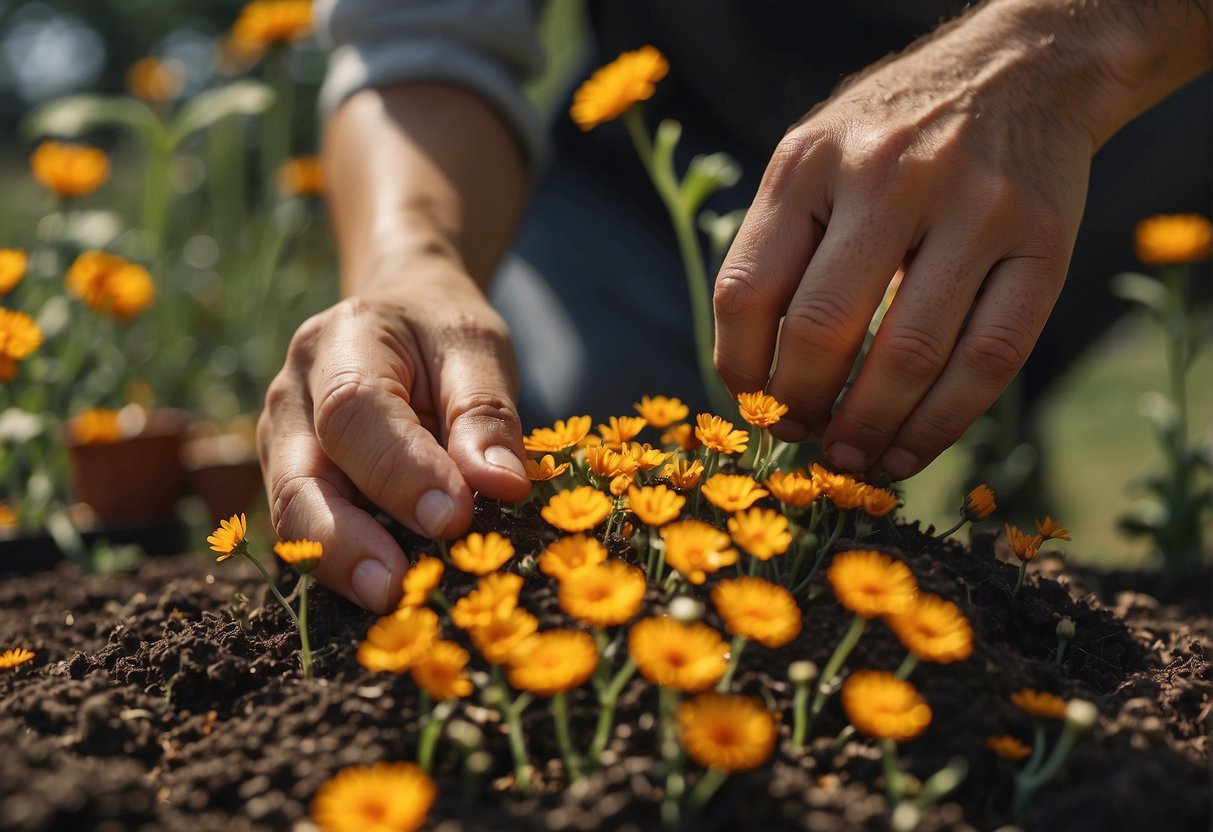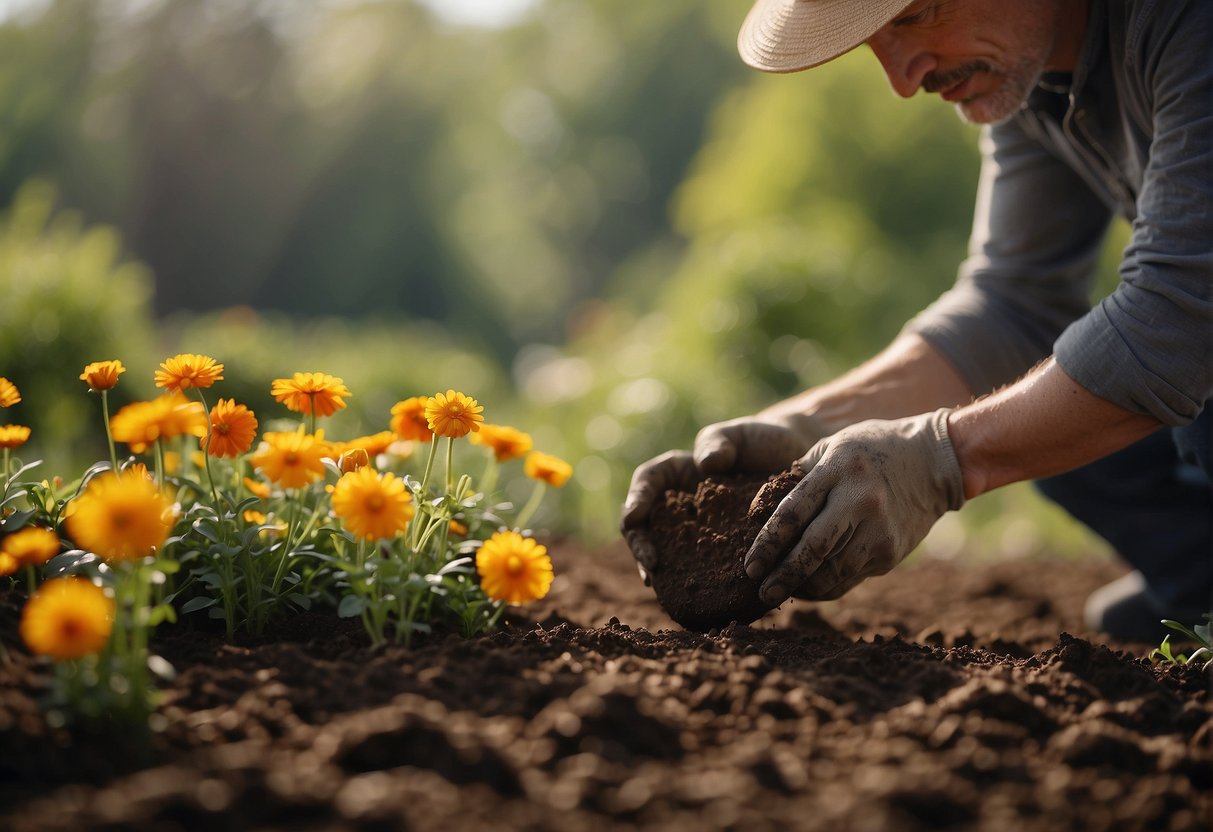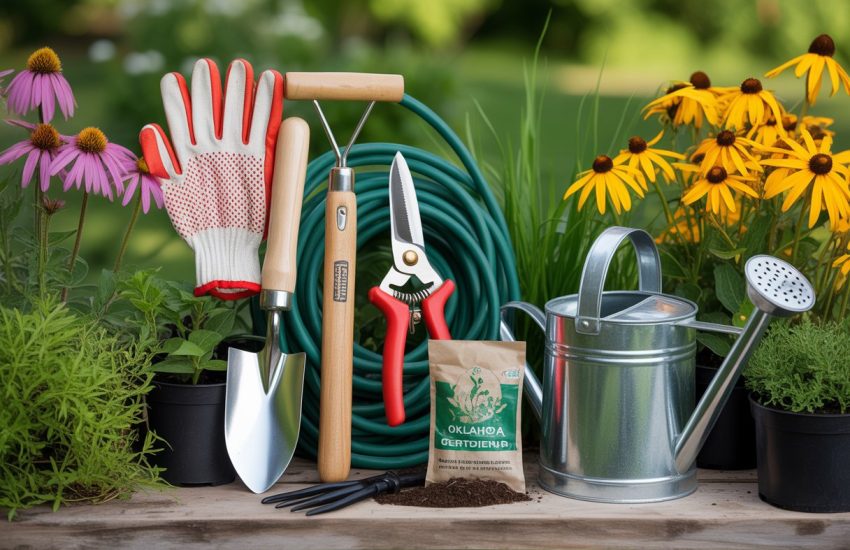Calendula: How to Plant and Grow Successfully
Calendula, also known as pot marigold, is a beautiful and versatile flower that can brighten up any garden. With its vibrant colors and medicinal properties, it’s no wonder that many gardeners are eager to learn how to plant and care for calendula. In this article, we will provide a comprehensive guide on planting calendula, including tips on soil preparation, watering, and fertilization.

When it comes to planting calendula, it’s important to choose the right location. These flowers thrive in full sun to partial shade, and they prefer well-draining soil. Before planting, make sure to prepare the soil by removing any weeds and adding organic matter, such as compost or aged manure. This will help improve the soil’s fertility and drainage, which are crucial for the health of your calendula plants.
Once you have prepared the soil, it’s time to plant your calendula seeds. Calendula is an annual flower, which means that it completes its life cycle in one growing season. You can either start your calendula seeds indoors in early spring or sow them directly in the garden once the soil has warmed up in late spring. In the next section, we will provide more detailed instructions on how to plant calendula seeds both indoors and outdoors.
Selecting the Right Variety

When it comes to selecting the right variety of calendula to plant, there are a few things to consider. Understanding Calendula Officinalis, color variations and flower forms, and annual vs. perennial calendula are all important factors to keep in mind.
Understanding Calendula Officinalis
Calendula Officinalis, also known as pot marigold, is a popular variety of calendula that is widely cultivated for its medicinal and culinary properties. This variety is easy to grow and produces beautiful, vibrant flowers that range in color from yellow and orange to red, cream, and pink.
Color Variations and Flower Forms
Calendula comes in a variety of colors and flower forms, making it a versatile plant for any garden. Some popular color variations include bright yellow and orange, while flower forms range from single blooms to double blooms and even pom-pom shapes.
Annual vs. Perennial Calendula
Another important factor to consider when selecting the right variety of calendula is whether to plant an annual or perennial variety. Annual calendula grows and blooms in a single season, while perennial calendula will come back year after year.
Overall, selecting the right variety of calendula depends on your personal preferences and gardening goals. Whether you are looking for a versatile plant for your garden or a medicinal herb to add to your collection, there is a calendula variety that is perfect for you.
Planting Calendula
Calendula is an easy-to-grow plant that produces beautiful, vibrant flowers. Planting calendula is a straightforward process that can be done both indoors and outdoors. In this section, we will cover the best time to plant calendula, soil preparation and requirements, and sowing seeds indoors and outdoors.
Choosing the Best Time to Plant
Calendula is a cool-season plant that grows best in spring and fall. In areas with mild winters, calendula can be planted in the winter as well. It is important to plant calendula after the last frost date in your area. In hardiness zones 8 and above, calendula can be planted in the fall for winter blooms.
Soil Preparation and Requirements
Calendula prefers well-drained soil that is rich in organic matter. Before planting, loosen the soil to a depth of 6-8 inches and remove any weeds or debris. If the soil is heavy or clay-like, add compost or other organic matter to improve drainage and fertility.
Sowing Seeds Indoors and Outdoors
Calendula seeds can be sown directly into the garden bed or started indoors and later transplanted outside. Sowing seeds indoors should be done about 6-8 weeks before the last frost date. Sow the seeds in a well-draining potting mix and keep the soil moist until the seeds germinate. Once the seedlings have grown to about 2-3 inches tall, they can be transplanted outside.
When sowing seeds outdoors, scatter them over the prepared soil and cover them lightly with soil. Keep the soil moist until the seeds germinate. Thin the seedlings to about 6-12 inches apart to provide enough space for the plants to grow.
In conclusion, planting calendula is a simple process that can be done by anyone. By following the guidelines outlined in this section, you can ensure that your calendula plants will thrive and produce beautiful blooms.
Calendula Care and Maintenance
Calendula is a hardy plant that requires minimal care and maintenance. However, here are some tips to ensure that your calendula plants remain healthy and vibrant.
Watering and Fertilization
Calendula thrives in well-drained soil that is moist but not waterlogged. Watering should be done regularly, especially during dry spells. Overwatering can lead to root rot, so it’s important to strike a balance.
Fertilization should be done sparingly, as calendula does not require heavy feeding. A balanced fertilizer can be applied once a month during the growing season.
Managing Pests and Diseases
Calendula is relatively resistant to pests and diseases. However, aphids and powdery mildew can still be a problem. To prevent aphids, keep the area around the plants clean and free of debris. Powdery mildew can be prevented by ensuring good air circulation around the plants.
If pests or diseases do appear, there are several natural remedies that can be used. For example, a solution of water and dish soap can be sprayed on the plants to deter aphids. Neem oil can also be used to control pests and diseases.
Deadheading and Pruning
Deadheading is the process of removing spent flowers. This encourages the plant to produce more blooms. Deadheading should be done regularly throughout the growing season.
Pruning can also be done to promote bushier growth and prevent the plant from becoming too leggy. This should be done in the early spring before new growth appears.
In summary, calendula care is relatively simple and straightforward. Regular watering, minimal fertilization, and pest/disease prevention are the key components of calendula care. Deadheading and pruning should also be done regularly to promote healthy growth.
Harvesting and Utilization

When and How to Harvest
Calendula flowers should be harvested when they are fully open and at their peak, which is typically in the morning after the dew has dried. The flowers should be picked regularly to encourage continued blooming throughout the season. To harvest, gently pinch the stem just below the flower head and pull it off.
Edible and Medicinal Uses
Calendula flowers are not only beautiful but also have a variety of edible and medicinal uses. The petals can be added to salads for a pop of color and a slightly spicy flavor. They can also be used in cooking to add a subtle saffron-like flavor and color to rice, soups, and stews. Medicinally, calendula has been used to treat skin irritations, wounds, and inflammation. It can be made into a salve, oil, or tea for internal or external use.
Drying and Storing Calendula
To dry calendula flowers, spread them out on a clean, dry surface in a single layer and allow them to air dry for several days until they are completely dry and brittle. Once dry, store them in an airtight container in a cool, dark place. Dried calendula flowers can be used in teas, tinctures, and infused oils for medicinal purposes or added to bath salts and potpourri for their fragrance and color.
Overall, calendula is a versatile and useful plant that can be enjoyed both for its beauty and its many practical uses. Whether used fresh or dried, in culinary or medicinal applications, calendula is a valuable addition to any garden or kitchen.
Companion Planting and Garden Design

Benefits of Companion Planting
Companion planting is a practice of planting different crops together to enhance growth, prevent pests, and improve soil quality. Calendula is an excellent companion plant that can benefit the garden in several ways. It attracts pollinators such as bees and butterflies, which are essential for the growth of vegetables and fruits. Calendula also repels harmful insects such as aphids, whiteflies, and tomato hornworms, which can damage the plants in the garden.
Moreover, calendula has a symbiotic relationship with some vegetables such as tomatoes, peppers, and beans. It helps to deter pests and diseases that commonly affect these plants. Additionally, calendula has a deep root system that can improve soil structure and fertility by breaking up compacted soil and adding organic matter.
Incorporating Calendula into Garden Spaces
Calendula is a versatile plant that can be grown in various garden spaces such as vegetable gardens, cottage gardens, containers, and beds. It is easy to grow and requires minimal maintenance.
In vegetable gardens, calendula can be planted alongside tomatoes, peppers, beans, and cucumbers. It can help to repel pests and attract pollinators, which can increase the yield of the crops.
In cottage gardens, calendula can be planted alongside other flowers such as roses, lavender, and daisies. It can add a pop of color and attract beneficial insects such as ladybugs and lacewings.
In containers, calendula can be grown alone or with other plants such as pansies, petunias, and marigolds. It can add a vibrant touch to the container and attract pollinators to the balcony or patio.
In beds, calendula can be used as a border plant or mixed with other flowers such as zinnias, cosmos, and sunflowers. It can provide a beautiful display of colors and attract beneficial insects to the garden.
Overall, calendula is an excellent companion plant that can benefit the garden in many ways. It is easy to grow, attractive, and has several uses in the kitchen and medicine cabinet. By incorporating calendula into garden spaces, gardeners can enhance the growth of their plants and improve the overall health of the garden.
Frequently Asked Questions

What is the best method for planting calendula seeds?
Calendula seeds should be planted directly into well-drained soil after the last frost of the season. The seeds should be sown at a depth of 1/4 inch and spaced about 6-12 inches apart. It is important to keep the soil moist but not waterlogged until the seeds have germinated.
Can calendula thrive in container gardens?
Yes, calendula can thrive in container gardens as long as the containers are at least 6 inches deep and have good drainage. Use a well-draining potting mix and keep the soil moist but not waterlogged. Calendula can be grown in small pots or hanging baskets, making them a great choice for small spaces.
What are the ideal growing conditions for calendula?
Calendula prefers full sun to partial shade and well-drained soil. They can tolerate a wide range of soil types, but prefer slightly acidic soil with a pH between 6.0 and 7.0. Calendula can be grown in USDA hardiness zones 2-11.
How should calendula be spaced for optimal growth?
Calendula should be spaced about 6-12 inches apart to allow for optimal growth. Proper spacing will also help prevent disease and pest problems. If planting in rows, space the rows about 12-18 inches apart.
What temperature range can calendula tolerate?
Calendula can tolerate a wide range of temperatures, but they prefer cooler temperatures between 60-70°F. They can tolerate temperatures as low as 20°F and as high as 90°F. In hot summer climates, calendula may benefit from some afternoon shade.
How much sunlight is required for healthy calendula growth?
Calendula prefers full sun to partial shade. They will grow best with at least 6 hours of direct sunlight per day. In hot summer climates, calendula may benefit from some afternoon shade to prevent wilting.

